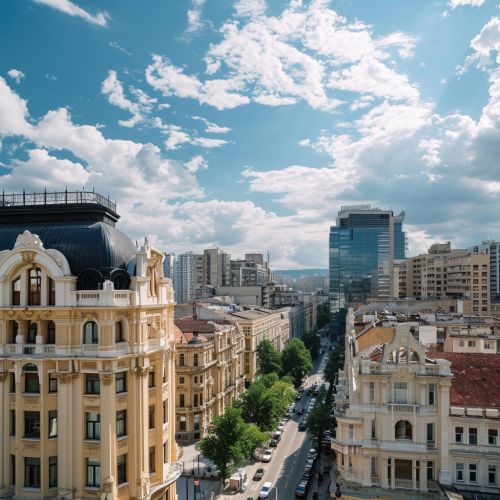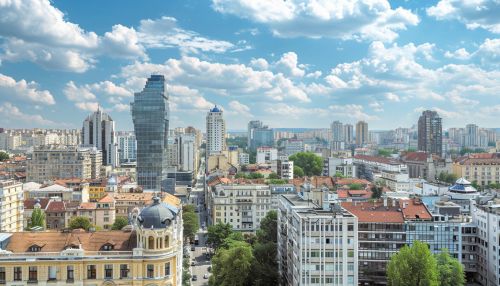Bucharest
Geography
Bucharest is the capital and largest city of Romania, located in the southeast part of the country, on the banks of the Dâmbovița River, less than 70 kilometers north of the Danube River. The city is situated on the plains of Wallachia, a historical region of Romania, surrounded by an arc of natural fortifications: the Carpathian Mountains to the north and the sub-Carpathian hills to the west.


History
Bucharest's history is long and complex, with evidence of human settlements dating back to the Paleolithic era. The city was first mentioned in documents as early as 1459, and became the capital of Romania in 1862. Over the years, Bucharest has gone through various periods of development and decline, reflecting the tumultuous history of Romania itself.
Early History
The earliest human settlements in the area of Bucharest date back to the Paleolithic era, as evidenced by archaeological finds. The first known fortifications were built by the Dacians, the ancient inhabitants of the area, in the 2nd century BC. The city was later conquered by the Roman Empire in the 1st century AD.
Middle Ages
During the Middle Ages, Bucharest was known as "the Citadel on the Dambovita", a reference to the river on which it is located. The city was first mentioned in documents in 1459, during the reign of Vlad III, also known as Vlad the Impaler, who is often considered one of the most important rulers in Wallachian history.
Modern Era
In the modern era, Bucharest has experienced periods of rapid growth and decline. The city became the capital of Romania in 1862 and experienced a period of significant growth and modernization during the late 19th and early 20th centuries. However, the two World Wars and the subsequent Communist regime had a profound impact on the city, leading to periods of stagnation and decline.
Architecture
Bucharest's architecture is a mix of historical, interbellum, Communist-era and modern styles. In the period between the two World Wars, the city's elegant architecture and the sophistication of its elite earned Bucharest the nickname of "Little Paris".
Historical Architecture
Bucharest's historical architecture is quite diverse. The city is home to many medieval churches and monasteries, the most notable of which is the Stavropoleos Monastery, built in 1724.
Interbellum Architecture
The interbellum period, between the two World Wars, was a time of significant growth and modernization for Bucharest. The city's architecture from this period is characterized by a mix of neoclassical and Art Deco styles.
Communist-era Architecture
The Communist era left a significant mark on Bucharest's architecture. Large, gray, utilitarian buildings dominate many parts of the city, the most notable of which is the Palace of the Parliament, the second largest administrative building in the world.
Modern Architecture
In recent years, Bucharest has been experiencing a real estate boom, with many modern and contemporary architectural projects changing the city's skyline.
Culture
Bucharest is a vibrant cultural hub, with numerous museums, theaters, concert halls and festivals that cater to a wide range of cultural tastes. The city is also home to several universities, libraries and cultural institutions.
Museums
Bucharest is home to over 50 museums. The most notable among them are the National Museum of Art of Romania, the Museum of the Romanian Peasant and the National Museum of Natural History.
Theaters and Concert Halls
Bucharest's cultural scene is enriched by numerous theaters and concert halls. The most notable among them are the Romanian Athenaeum, a landmark of the Romanian capital city and one of the most prestigious concert halls in the country, and the National Theatre.
Festivals
Bucharest hosts numerous local and international festivals and events throughout the year, ranging from classical music concerts and film festivals to rock concerts and street fairs.
Economy
Bucharest is the economic center of Romania, accounting for around 23% of the country's GDP and about one-quarter of its industrial production, while being inhabited by 9% of the country's population. Almost one third of national taxes is paid by Bucharest's citizens and companies. The city's strong economy is based in commerce, services, IT and telecommunications, and industrial production.
Education
Bucharest is an important national and regional center of higher education. The city is home to the University of Bucharest, the Technical University of Bucharest, the Bucharest Academy of Economic Studies and the Politehnica University, among others.
Transport
Bucharest has a complex system of public transportation that includes buses, trams, trolleybuses and a metro system. The city is also served by two international airports: Henri Coandă International Airport and Aurel Vlaicu International Airport.
